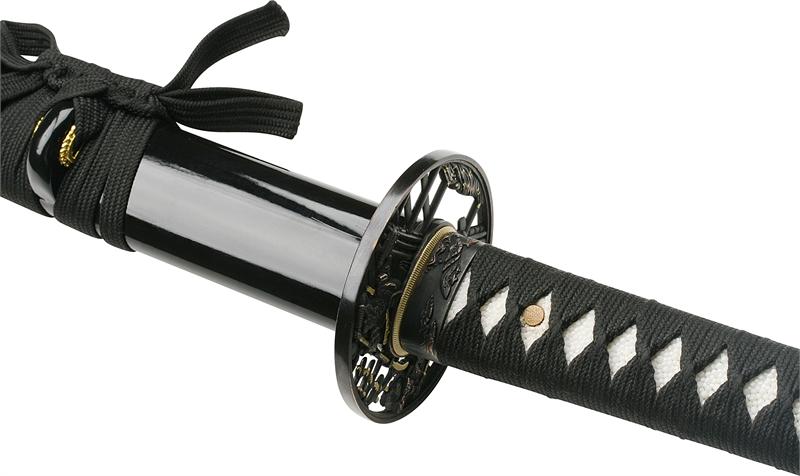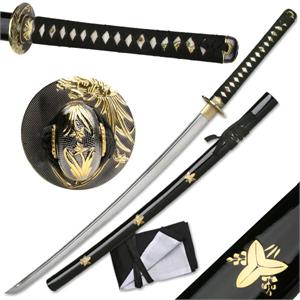

The Japanese swords we deal with are hand-forged edged swords made in Japan. We deal with antique Samurai swords/armor, traditional crafts made in Japan and so on. Samurai Museum Shop is the place for those who are interested in Japanese culture and craftsmanship. Samurai Museum is located in Tokyo, Japan, exhibiting antique artifacts related to the Samurai history. This paper will need to be returned to the board of education when the sword being shipped abroad but you can receive a copy of it. With this paper, its owner can legally own an authentic Japanese sword in Japan. In order to obtain this paper, the sword needs to be traditionally hand forged.
#Masahiro ikuna katana registration
The Board of Education in Tokyo prefecture issued a registration paper for this sword.
#Masahiro ikuna katana pdf
We can also translate what is written into English and make a PDF file for your record if you request. The purchaser will receive this original certificate as well. They appraised it as Hozon Touken, the blade worth preserving for Japanese society. They authenticated the blade on Feb 19th in the second year of Reiwa(2020). NBTHK, also known as Nihon Bijutsu Touken Hozon Kyokai (the Society for the Preservation of the Japan Art Sword), is one of the oldest Japanese sword appraising organizations in modern-day Japan. Saya: Saya is the scabbard for the Japanese sword.Īuthentication Paper: NBTHK Hozon Certificate for the blade This motif has also been appreciated for family crests. It is a migratory bird that represents fall. Five wild geese are designed with a very simplified shape. The Kari (雁, wild goose) pattern is engraved at the Tsuba’s upper and bottom. It prevents the blade from getting rusty and chipped.Ĭircle-shaped Tsuba made from iron. Tsuba and Habaki: Tsuba is the handguard for the Japanese Sword and Habaki is the equipment to make the blade not touch its scabbard inside. Based on the idea that this shape implies a perspective of the future, people appreciate this design. A fan has a characteristic shape, and it is called Suehirogari (末広がり) in Japanese. The fan motif has been favored as an auspicious pattern that represents development and prosperity. It is challenging to judge what motifs of this Menuki are. Tsuka and Menuki: Tsuka is the handle of the Japanese sword and Menuki is its decoration. It seems the motif of this Fuchi Kashira was quoted from folklore or a story and depicts one of these scenes. There are several parts that consist of Koshirae such as Saya(Sabbard), Tsuka( Handle), Tsuba(Handguard).įuchi-Kashira: A pair of matching sword fittings that cover the upper and bottom parts of its sword hilt.Ī man is engraved for the Kashira part of this Fuchi Kashira. Koshirae: Koshirae is the mounting of the Japanese sword. Visible steel surface pattern created by folding and hammering during forging process The crystalline structure which forms along the cutting edge of a blade as a result of the hardening process The red-colored scabbard complements this elegant blade.Ĭutting Edge Length(Nagasa): 71.4 cm(28.1 inches) This authentication paper was only given to Japanese swords, worth preserving by Nihon Bijutsu Touken Hozon Kyokai(the Society for the Preservation of the Japan Art Sword). It comes with Hozon certificate issued by NBTHK. Those aren’t considered serious defects, but if you like, we can have them polished without any additional charge. There are partial black rusts on a couple of spots on the blade. This blade has beautiful Suguha Hamon(straight tempering line). Tokugawa family even recognized Masahiro’s craftsmanship. Mitsukuni was a grandson of one of the most famous Samurai, Tokugawa Ieyasu. Masahiro was Okakaekaji for Mito Mitsukuni, the feudal lord of the Mito domain in Ibaraki prefecture. The second-gen Masahiro belonged to Houjyoji school, and his work has a close resemblance to his master.

The second-gen Masahiro forged swords during Enpo-Genroku era(1673-1704) based on his remaining works. The title of Kami was only given to highly regarded swordsmiths back then. Father and son(the second-gen Masahiro) both received Oumi no Kami. The school run by him was prosperous during the early Edo period. It is said that the first-gen Masahiro was originally from Tajima region(Hyogo prefecture) and moved to Edo city. Antique Japanese Sword Katana Signed by Masahiro with NBTHK Hozon CertificateĪccording to NBHTK that authenticated this blade, it was forged by the second-gen Omino Kami Houjyoji-Tachibana-Masahiro(近江守法城寺橘正弘).


 0 kommentar(er)
0 kommentar(er)
